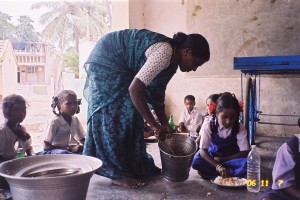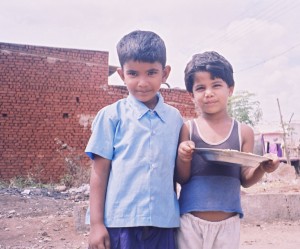In 2001, the Supreme Court ordered that the states should provide cooked meals for all school-children up to the fifth standard. The primary objective was to retain the students in the classrooms, rather than lose them to hunger and family pressures for additional income. Four years later, in the southern states of Karnataka and Andhra Pradesh, the statistics show that this primary objective has been met. School authorities say, and the records show, that while enrolment has not been substantially improved as a result of the meal programmes, school attendance has certainly gone up by 10-12%. However, there is plenty of room for improvement in the management of the scheme, and in maintaining the quality of the food provided.
The introduction of mid-day meals scheme (MMS) was the result of a Public Interest Litigation (PIL) filed by the People's Union for Civil Liberties, Rajasthan, before the the Supreme Court. The case was filed initially against the Government of India, Food Corporation of India (FCI) and six state governments, alleging that more than 50 million tonnes of food grains was stocked up with FCI while there was widespread hunger in the country, particularly in the drought-hit states of Rajasthan and Orissa. Eventually the list of respondents was extended to include all the States and Union Territories. The Supreme Court issued an order asking the states to implement eight different centrally-sponsored schemes for food security and to introduce cooked mid-day meals in all the government and government-aided schools. Later, in 2003, the Government of India announced that the scheme would thereafter cover students up to the seventh standard.
Karnataka
The Karnataka government began its mid-day meals scheme in June 2002. Initially, the programme was limited to seven backward districts of the state - Raichur, Koppala, Gulbarga, Bidar, Bellary, Bagalakote and Bijapur. Later, in 2003 under the ambitious "Akshara Dasoha" programme, the remaining 20 districts were also included in the scheme. By the year 2005-06 the programme covered close to five lakh government schools and nearly seven lakh government-aided schools in the state. The government had budgeted Re.1 per child per meal initially; this was raised to Rs.1.31 per student per day subsequently. This is the lowest amount spent per child among the southern states. Each child gets 100 grams of rice per day from the FCI under this scheme.

![]() Picture: A self-help group member serving children in Anantapuram.
Picture: A self-help group member serving children in Anantapuram.
Records at the Department of Public Instruction show that school attendance has improved since the introduction of the scheme by 2-10% across the state. The attendance registers at schools corroborate this data. But a closer look at a few of the many government schools benefiting from the programme shows there is considerable room for improvement in the implementation.
The Government High School in Ghousianagar, Mysore, tells the tale of loopholes in the scheme. This school, with a thousand students, does not have a kitchen for the meals to be cooked. To overcome this difficulty, one of the classrooms has been converted into a kitchen, but this means that the students are crammed into smaller classrooms. Nor does the school have regular water supply; Chandrashekar, the Headmaster, says during my visit that "We have not got water for the last three days. This happens quite often here, and we have to get water from far away places." Then there is the problem of under-staffing; for a thousand-strong student population, there are only four cooks and assistants. This means that the teachers even have to spend considerable amount of time in overseeing the preparations and even serving the meals on a daily basis. Chandrashekar says they lose 80 minutes of school time every day because of this.
Yellappa, the headmaster of Huskur Government Primary and Middle School near Bangalore, shares the same frustration. He says when the scheme started, he and the other teachers of the school had to find the cooks, source vessels, and oversee every day's cooking. He says "it was the most difficult time for us. The cooks were not paid enough, so they were very unhappy and did a bad job, and would even steal the rations meant for children. But if we questioned them, they would show their anger on the food, and the children would suffer."
The situation improved when the state government decided to rope in NGOs to prepare the meals at a central kitchen and supply them to the schools. Bangalore-based ISKCON's Akshaya Patra is one of the most successful private sector participation programmes of this kind. Samarthanam, a trust for the disabled in Bangalore, is another organisation that is participating in this programme. They started with 3500 students in the year 2003-04 and are currently providing food for nearly 23,000 students in and around Bangalore and Anekal. There are currently 38 NGOs participating in the 'Akshara Dasoha' programme, covering 1001 schools. But even this arrangement has not been without problems.
These problems notwithstanding, both government authorities and school teachers find this arrangement - NGOs providing meals - more reliable and hassle free. The state government is now considering roping in more NGOs. On the other hand, the cooks employed by the schools are not happy about this development. Members of the Karnataka State Akshara Dasoha Bisi-Oota Tayarakara Federation across the state have been staging demonstrations against handing over of mid-day meals programme to private individuals and organisations. They say they would lose employment that fetches them Rs.300 to Rs.650 per month by this decision; the NGOs prefer to hire their own people, who they believe will be easier to manage than the unionised cooks.
Caste problems, too, are never far away from the MMS. The cooks employed are mostly Dalit women; their appointment has cooks has not worked in favour of the mid-day meals scheme. In many villages, upper caste members have refused to allow their children to consume meals prepared by Dalit cooks. A survey conducted by a research team of the Centre for Equity Studies, Delhi in 2003 in Karnataka, as well as in Chattisgarh and Rajasthan, found that in some of the upper caste-dominated areas, only Dalit children make use of the scheme. Nonetheless, 91% of the parents and 84% of the teachers favoured the continuation of the scheme; those who advocated discontinuation belonged mainly to privileged castes or classes who view the mid-day meals as a threat to the prevailing social hierarchy.
Andhra Pradesh
A similar situation prevailed in the neighbouring Andhra Pradesh's Chittoor district, until a few years ago. In this district, which borders Tamilnadu, most of the residents are landless labourers who migrated from Tamilnadu, and belong to the Dalit community. When the Andhra Pradesh government launched the mid-day meals scheme in January 2003, it worked as a boon to the daily wage-earning parents. But the upper caste members raised objections against the appointment of Dalit women as cooks, and their children having food alongside Dalit students. Sahanivasa, an NGO working for Dalit rights in the region, intervened. Manoharan, Sahanivasa's field coordinator, says, "earlier we had problems; now there is awareness among both Dalits and upper caste members so we do not have such issues, at least in the open in this area."
Naandi Foundation, Hyderabad is one such organisation. Leena Joseph, Programme Officer, says "we have seen considerable improvement in the attendance levels after the scheme was started." The foundation now provides food to students in Hyderabad, Secunderabad and Vishakapatnam. Leena echoes what her counterparts in Karnataka are saying, "the money does not come on time." The menu provided includes a fruit and an egg once a week, and soya and peanuts for extra protein - a luxury that students in the rural areas are otherwise deprived of.
But the scheme's implementation is often erratic. Thirty students in the Anantapuram Government Primary and Middle School in Chittoor district have been eating just rice and sambhar - with only tomatoes and no vegetables - for the last one week. The reason: the government has not provided the money for the last three months.
S Lilly, a local SHG member, is in charge of providing the meals. She says "I am borrowing money from the teachers and villagers to give these children food every day. I have not been paid in the last three months. I don't get anything out of this. But I feel very bad to deprive children of their food." The school building has just one room which serves as the classroom. Lilly stores the rice and cooks it in the backyard of her house. When it rains, she has to move the setup into her tiny kitchen. She has long since stopped using LPG for cooking because she does not get it on time. But the children are not complaining; they are only too happy to get their meal. One student, Chandran, even packs lunch for his brother who did not come to the school because he was ill.
Hariprasad, one of the two teachers in the school, says attendance has certainly improved, not only in his school, but in schools in the villages around here too. The teachers estimate that the attendance has improved by 15%. Karpagam, a single parent and a daily wage earner from neighbouring Kuruchivedu village, says, "both my sons are enthusiastic about going to school now. Earlier, if I had to go far away for work I couldn't cook for them, and on such days they would skip school. But now I am relieved that they get food in the school, and they too are very happy." However she adds that it will be nice if the authorities could provide more vegetables, and eggs once in a while.

![]() Picture: Children in Ghousianagar, Mysore taking mid-day meals home.
Picture: Children in Ghousianagar, Mysore taking mid-day meals home.
In August 2006, the Andhra government decided to add eggs to the mid-day meals, and increased the amount allocated to Rs.2.50 per child per day. Lilly, however, says that ever since, she has not received the money anyway, so she has not been able to provide even vegetables, let alone eggs. When Lilly and I enquired at the local office about the delay in disbursing the money, the authorities cited a 'clerical error' as the reason.
The Karnataka government has also decided to raise the nutrition provided by the MMS, and plans to include bananas, milk and eggs in the menu. The students will have an option to choose any one of these three items, as per the decision announced in the second week of November. The government hopes to address the concern expressed by the Professor U R Rao Committee - which looked into the formulation of Science and Technology policy in the state - in 2005 that the mid-day meals lacked nutrient value. The government has announced an additional allocation of 50 paise per child per meal to meet the cost of the improved menu.
The hiccups in the scheme are quite evident and wide-spread, but there is no denying that it has helped dent the prevalence of hunger, and is clearly helping people like Karpagam and Chandran. With the state governments now turning their attention to the quality of the meals, parents and teachers are hopeful that we will soon see improvements in the scheme's implementation too.

